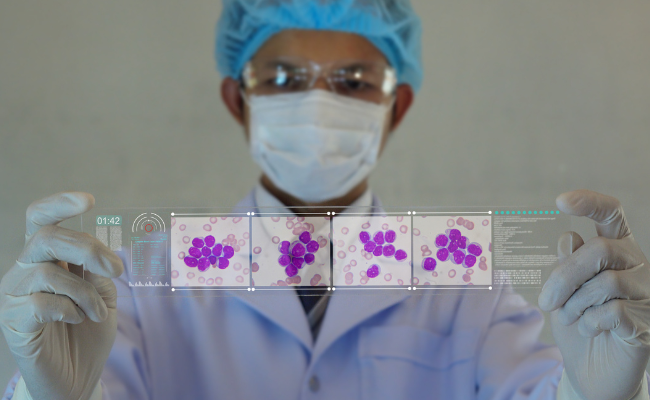How to Treat Hairy Cell Leukaemia?
- February 01, 2024
- No Comments

What is Hairy Cell Leukemia (HCL)?
Hairy Cell Leukemia (HCL) is a rare subtype of chronic lymphocytic leukemia characterized by the abnormal proliferation of B lymphocytes, termed hairy cells. These atypical cells infiltrate the bone marrow and spleen, resulting in various complications. The name "hairy cell leukemia" stems from the microscopic appearance of these cells, exhibiting a distinctive hairy or fringed appearance. Recognizing the nature of Hairy Cell Leukemia is vital for accurate diagnosis and the formulation of effective treatment strategies to manage this uncommon yet impactful blood cancer.
Why Does Hairy Cell Leukemia Occur?
The precise cause of Hairy Cell Leukemia remains elusive, but it is believed to originate from genetic mutations within B lymphocytes. These mutations result in the distinctive appearance of hairy cells and interfere with the usual process of blood cell formation. While environmental factors and exposure to certain chemicals may contribute to the development of HCL, the specific triggers for these genetic mutations are not fully understood.
How Does Hairy Cell Leukemia Affect the Body?
Hairy Cell Leukemia primarily affects the bone marrow and spleen. The overproduction of hairy cells disrupts the normal balance of blood cell production, leading to cytopenias characterized by low blood cell counts. This imbalance gives rise to complications such as anemia, an increased susceptibility to infections, and an enlarged spleen. The infiltration of hairy cells into the bone marrow further compromises its function, contributing to the unique features of HCL.
Treatment Solutions for Hairy Cell Leukemia
Managing Hairy Cell Leukemia involves a multi-faceted approach aimed at eliminating or controlling the abnormal cells. Here are key treatment solutions:
Chemotherapy:
- Cladribine and pentostatin are commonly employed chemotherapeutic agents for HCL.
- These medications target the abnormal hairy cells, aiming to reduce their presence in the bone marrow and spleen.
Biological Therapy:
- Rituximab, a monoclonal antibody, may be used in combination with chemotherapy to enhance treatment efficacy.
- Rituximab specifically targets proteins on the surface of hairy cells, aiding in their elimination.
Interferon Therapy:
- Interferon-alpha, a biological response modifier, can be utilized in the treatment of Hairy Cell Leukemia.
- This therapy boosts the body's immune system, helping to control the growth of hairy cells.
Splenectomy:
- In cases of significant spleen enlargement or persistent cytopenias, surgical removal of the spleen (splenectomy) may be considered.
- Splenectomy can provide relief from symptoms and improve blood cell counts.
Targeted Therapy:
- The introduction of targeted therapies, such as the BRAF inhibitor vemurafenib, represents a promising development for HCL cases with specific genetic mutations.
- These therapies aim to inhibit abnormal signaling pathways in hairy cells, offering a more precise and effective approach.
Clinical Trials:
Participation in clinical trials may be an option for individuals seeking access to novel treatments and contributing to the ongoing advancements in HCL management.
Benefits of Treating Hairy Cell Leukemia
Effective treatment of Hairy Cell Leukemia yields numerous benefits for individuals grappling with this rare blood cancer:
Remission and Symptom Relief:
- Treatment endeavors to induce remission, significantly reducing or eliminating abnormal hairy cells from the bone marrow and spleen.
- Symptom relief, including improvements in blood counts, translates into reduced fatigue, lowered infection risks, and an enhanced overall sense of well-being.
Improved Quality of Life:
- Successful treatment contributes to an improved quality of life by managing symptoms, reducing spleen enlargement, and restoring normal blood cell production.
- Individuals experience enhanced daily functioning and an improved ability to engage in daily activities.
Long-Term Management:
- Maintenance therapies or ongoing monitoring may be recommended to manage HCL in the long term, preventing relapses and sustaining remission.
- Long-term management ensures sustained improvements in health and a minimized risk of disease recurrence.
Prevention of Complications:
- Timely and effective treatment helps prevent complications associated with Hairy Cell Leukemia, such as infections and anemia.
- Avoiding or mitigating complications contributes to an overall better prognosis and long-term health.
Spleen Function Improvement:
- For cases involving splenomegaly, splenectomy improves spleen function and alleviates symptoms associated with spleen enlargement.
- Enhanced spleen function positively impacts overall health and reduces the risk of complications.
Advancements in Targeted Therapy:
- The emergence of targeted therapies offers new possibilities for individuals with specific genetic mutations, providing more tailored and effective treatment options.
- Advancements in targeted therapy represent a significant stride toward precision medicine in the treatment of Hairy Cell Leukemia.
Enhanced Survival Rates:
- Early diagnosis and appropriate treatment contribute to improved survival rates, allowing individuals with HCL to lead longer and healthier lives.
- Improved survival rates signify the efficacy of treatment interventions and the positive impact on overall life expectancy.
Comments (0)